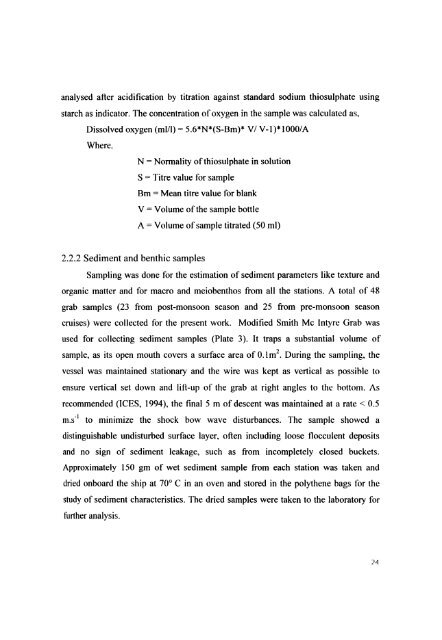L - Cochin University of Science and Technology
L - Cochin University of Science and Technology
L - Cochin University of Science and Technology
Create successful ePaper yourself
Turn your PDF publications into a flip-book with our unique Google optimized e-Paper software.
analysed after acidification by titration against st<strong>and</strong>ard sodium thiosulphate using<br />
starch as indicator. The concentration <strong>of</strong> oxygen in the sample was calculated as,<br />
Dissolved oxygen (mill) = 5.6*N*(S-Bm)* VI V-l)*lOOOIA<br />
Where.<br />
N = Normality <strong>of</strong> thiosulphate in solution<br />
S = Titre value for sample<br />
Bm = Mean titre value for blank<br />
V = Volume <strong>of</strong> the sample bottle<br />
2.2.2 Sediment <strong>and</strong> benthic samples<br />
A = Volume <strong>of</strong> sample titrated (50 ml)<br />
Sampling was done for the estimation <strong>of</strong> sediment parameters like texture <strong>and</strong><br />
organic matter <strong>and</strong> for macro <strong>and</strong> meiobenthos from all the stations. A total <strong>of</strong> 48<br />
grab samples (23 from post-monsoon season <strong>and</strong> 25 from pre-monsoon season<br />
cruises) were collected for the present work. Modified Smith Mc lntyre Grab was<br />
used for collecting sediment samples (Plate 3). It traps a substantial volume <strong>of</strong><br />
sample, as its open mouth covers a surface area <strong>of</strong> 0.lm2. During the sampling. the<br />
vessel was maintained stationary <strong>and</strong> the wire was kept as vertical as possible to<br />
ensure vertical set down <strong>and</strong> lift-up <strong>of</strong> the grab at right angles to the hottom. As<br />
recommended (ICES, 1994). the final 5 m <strong>of</strong> descent was maintained at a rate < 0.5<br />
m.s- I<br />
to minimize the shock bow wave disturbances. The sample showed a<br />
distinguishable undisturbed surface layer. <strong>of</strong>ten including loose flocculent deposits<br />
<strong>and</strong> no sign <strong>of</strong> sediment leakage, such as from incompletely closed buckets.<br />
Approximately 150 gm <strong>of</strong> wet sediment sample from each station was taken <strong>and</strong><br />
dried onboard the ship at 70° C in an oven <strong>and</strong> stored in the polythene bags for the<br />
study <strong>of</strong> sediment characteristics. The dried samples were taken to the laboratory for<br />
further analysis.<br />
24

















